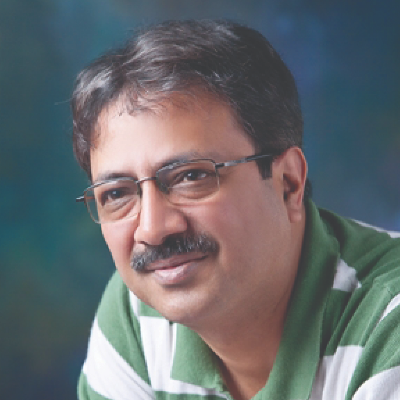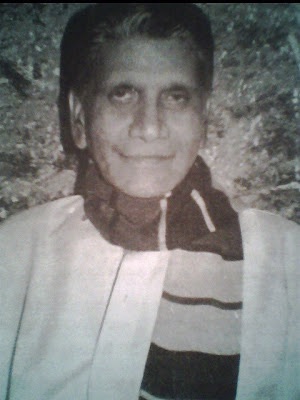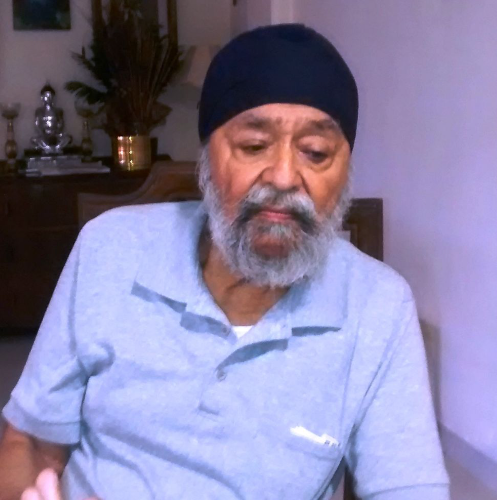Basu Chakraborty: The Forgotten Panchamite
One of the nine jewels or navaratnas of R.D. Burman’s core team of musicians, the contribution of Basu Chakraborty has escaped the attention it deserves in the wave of the Pancham mania that has swept the music industry after the death of the composer. Anirudha Bhattacharjee looks at the life and work of this forgotten ratna…
Prologue
The late musician Bhanu Gupta was once flagged down at a traffic light for speeding in the Flora Fountain area of Bombay. To add insult to injury, he had forgotten to carry his driving licence. After his attempts to humour the rustic traffic police inspector failed, he tried throwing in an introduction. ‘Have you seen Sholay (1975)? If yes, do you remember the scene where Amitabh Bachchan plays the harmonica while Jaya Bhaduri puts off the lamps?’
An affirmative nod from the policemen goaded Gupta to shell out more information. ‘Well, I played the harmonica you heard in the film.’ Needless to say, not only was Gupta let off immediately, he also made a fan that evening.
The harmonica refrain, which became the film’s emotive voice cutting through the narrative of violence, was composed, not by R.D. Burman as believed, but by his most senior assistant-cum-arranger, Basu Chakraborty. As was the introductory theme to Gabbar Singh, which, in contrast, was a most chilling piece of background music, suggesting a burst of ferocity to follow.
Calcutta Days
Basudeb Chakraborty was born in Calcutta on 23 January 1928 to Basanta Kumar Chakraborty and Krishna Mohini Devi. He was the tenth and the last child in a family of five brothers and five sisters. The family resided at 17, Sikdar Bagan Street, in Hatibagan area, north Calcutta. The Chakraborty family originally came from Dakshkin Barasat in South 24 Paraganas. Basu was born when his father, the head clerk at John King company, was fifty-nine and on the verge of retirement.

Picture Courtesy: Mita Swapna Chakraborty
Basu would later tell the story to anyone who was willing to hear.
Kamala Kinkar had started a music school near his house, which many musicians used to frequent. One of them was a young V.G. Jog who made Kamala Kinkar his shagird and also trained some more pupils at the school. However, Basu Chakraborty’s formal training had already started under Basanta Gupta. Gupta was a well-known fiddler and also an assistant to K.C. Dey, adept at both the Hindustani and Western styles. His disciples include the who’s who of instrumental music in Calcutta during those days, not least of all musicians like Kazi Aniruddha (Kazi Nazrul’s son). He taught Basu the violin, the viola and the cello. The mix of Indian classical and sheet music basics would add immense value to Basu’s career.
It was in his teens that Basu started earning. Bandhab Samaj Club, an institution nearby, used to hold jatras (Bengali folk-form theatre). One famous jatra was Nadia Binod in which renowned actor Chhabi Biswas was cast as Nimai, the lead character. Basu’s professional life as a string-section musician started there.
In the 1940s, the rate per shift for violinists in Calcutta was Rs 12. Violin/viola were common instruments too and shifting to cello seemed a more viable alternative. The competition was less. Cello demanded musicians who were large and strong enough to hold and manage the huge instrument. The rate per shift for cellists was Rs 18, considerably higher too. Basu, who had initially dreamt of a career as a violist, shifted to the cello.
Till the late 1950s, film producers in Calcutta would enter into a contract with professional orchestras for the background scores. Basu joined Surashree Orchestra, whose other members included Manohari Singh and Radhakanta Nandi (Manna Dey’s favourite tabla player). Two more orchestras were famous during that time: the Calcutta Orchestra and the National Orchestra. While there were musicians who worked with multiple orchestras, Basu normally stuck to the north Calcutta–based troupe. The principal reason was time; Basu was working for composers like R.C. Boral, Pankaj Mullick and Anupam Ghatak as well. And working on the most famous Bengali radio play ever: Mahisasuramardini.
Basu’s association with the play started in 1948. It used to be played live then, till a version was recorded for the radio a few years later. A car from AIR would pick him up at 12 in the night sharp. Birendra Krishna Bhadra, who used to do the Chandi Paath, was a neighbour. He used to get down at the Ganga ghat, perform a ritualistic bath at the river around 12:30 a.m., and then go to the radio station to be physically and mentally in a pure state for the Chandi Paath. Interestingly, nobody, including Pankaj Mullick who directed the music, had an inkling that they were creating history.
Basu’s work as a cellist had impressed Mullick deeply, and he would be summoned quite often for arrangement and handling the string section, apart from playing the cello. Zalzala (1952) was a Bombay production which Mullick was working on at that time. He handled the music from Calcutta. Paul Zils, the director of Zalzala, had started another film, Situm, where Mullick was again the music director. This film remained incomplete.
While Mullick was reluctant to move to Bombay (he never did), the partition had ensured that Calcutta was fast losing its importance as a centre of cinema. The viewership of Bengali films had lessened considerably as East Bengal was part of Pakistan and trade between the two countries was prohibited. While the focus had shifted to Bombay, and many from Calcutta had actually moved there, Madras had emerged as the more professional of the two centres.
In 1953, Basu tried his luck at Madras, only to return in a year. Though not much is known about this year of his career, one could hazard a guess that maybe the weather or the food did not suit him, as work surely was not a problem. He loved a strict regime that was in sync with the working style in Madras. It could have been the language as well.

Picture Courtesy: Mita Swapna Chakraborty
During this comparatively lean period, he found work with a new film-maker, Satyajit Ray. Basu worked in four films of Ray in which Pandit Ravi Shankar was the composer. He was also formally credited in the titles of Aparajito (1956).
The Bombay Chapter
While film production in Calcutta was no longer a businessman’s dream, the artistic integrity of the erstwhile capital of India was never in doubt. Musicians were in demand. If not inside the film studio, definitely for concerts. It was during one such concert that Salil Chowdhury and Naushad – incidentally both at loggerheads where musical ideas were concerned – saw Basu and Manohari performing. Both agreed, and unanimously, that these artistes mandated a greater stage. The next thing Basu knew was a train ticket to Bombay tucked in his pocket. He stayed as a guest at Salil Chowdhury’s house.
While the initial phase was spent in search of work, there was other important work to attend to at home. Marriage. On 27 November 1956, Basu wed Pootul Bhattacharjee in Calcutta. The guest list included many musicians, and those who attended recall Kazi Aniruddha playing the slide guitar. Post marriage, he moved to the mezzanine floor of a tenement in an unposh area of Bombay. Basu was a tall man, all of 6 feet (give or take an inch), and he used to have the feeling that his head would hit the ceiling of his one-room apartment.
Bombay, however, did not offer work on a platter. Group dynamics, politics, nepotism, etc., played a major role, mostly because the music fraternity was fragmented, based on caste, religion and, particularly language. Bengali musicians especially were not welcome. But work Basu did find. By late 1957/early 1958, Manohari was also in Bombay. Salil Chowdhury needed a fiddler in his team and Manohari suggested that Basu might use his clout to get his nephew in, and by the end of 1958, Babloo Chakraborty, grandson of late Sanat Chakraborty, was in Bombay too.

Picture Courtesy: Mita Swapna Chakraborty
How good was he as a cellist? Basu came to Bombay when most cellists were from Goa. He was probably the first Bengali from Calcutta who made a living as a cellist-cum-arranger. An interesting case study could be the song ‘Ek din aur gaya’ (Manna Dey in Door ka Rahi, 1971), where the cello serves as the base for most of the fillers including the prelude. The arrangement was Basu’s. The cellist was Basu too. Reason enough for composer Kishore Kumar to become his fan for life, pestering him to accompany him on his trips abroad even when Basu had virtually no role to play there. Basu would play the piano on these tours as carrying a cello would be a rather difficult task. Suffice it to say, a Kishore Kumar composition would be incomplete without Basu Chakraborty. He would be the first and often the only one to receive a phone call after Kishore completed a composition: ‘Buddy, I’ve washed my hands of the song. Now it’s your baby.’
Basu also did some work as a composer with his friend Manohari. He composed for films with stringent budgets, and with actors who were not exactly saleable. Given the limitations of time, cost and resources, the results were fabulous. The duo started with an untitled film Jalal Agha was making sometime after his debut in Bambai Raat Ki Bahon Mein (1968). Basu had composed two songs to lyrics by Majrooh. A cabaret for Asha, ‘Dillagi nahin dil ka lagana’. And a romantic solo for Lata, ‘Bheegi bheegi palken kyon bhare bhare nain’. The film, about a psycho killer, could never get off the ground. The next film was Yasmeen (1973), and unfortunately, while the songs were recorded, the film had issues and was not released. Two songs from the film went into Deven Varma’s Chatpatee (1983). These have great recall value today, especially among aficionados.

Picture Courtesy: Mita Swapna Chakraborty
Contrary to the perceived notion of a devoted workaholic, Basu also had a lighter side. He was an avid chess player and one often found him engaged in the game with Pancham or Hrishikesh Mukherjee. He also loved cards, and his family in Calcutta remember him as a good player of both the versions of bridge – auction and contract. To the musicians, however, Basu had a military-like demeanour. He tried to preserve the façade of a perennially strict person. The façade did break at times. Like it happened when his nephew, Deba Prasad Chakraborty, suddenly died at the age of forty-two in April 1981. Deba was a fiddler in Pancham’s team and Basu’s constant shadow. Basu found it difficult to cope with the tragedy and probably never recovered from the shock. In February 1982, Basu had a heart attack after which the doctor advised him not to conduct orchestras during recordings. He had to cut down work during this phase. Satte Pe Satta (1982) was the last film where he wrote notations and obligatos for Pancham.
As with most upright persons, Basu was hot-headed. Disagreements and confrontations even led to the hurling of notation sheets during sittings and at Film Center. Another member’s penchant for bossing around was also a reason for his impatience. Pancham would then call his Basu-da: Why do you keep losing your temper? Please come at 10 a.m., there’s a sitting at my place. And Basu would be back. There would be instances when Pancham would personally bring him to the sitting or the recording. This did not happen one day. Basu, perhaps charged up too emotionally to see reason, never came back to arrange. Consequently, the task was handed over to Babloo. One, to keep the ties with the family intact. Two, to maintain the style Basu had built through the years.
Many years later, Pootul Chakraborty saw Bappi in a – you guessed it – jewellery shop. Trepidation writ on her face, Mrs Chakraborty was not sure if Bappi would recognize her. She was mistaken. Bappi came to her, touched her feet and confessed how indebted he was to the family which supported him when he was a rookie in Bombay. Basu Chakraborty was no longer around then. He had passed away on the night of his son’s birthday in 2001. As it happened just after midnight, the official death certificate bore the date 27 July 2001. He was very eager to meet his daughter who had settled down at Sacramento, CA, and was planning to come later that year. It never happened.
Afterword
In the wake of the Pancham wave after his death, musicians, the unsung heroes, gradually found a platform to display their skills. Unfortunately, Basu Chakraborty was a name that hardly came up during the shows organized around the country. For one, he was not present post-2001. Secondly, very few shows had the budget to use a string quartet (usually two violins, one viola, and one cello), forget an entire string section with four rows of violins. Also, the stage sizes were far too small to accommodate a violin ensemble. Demonstration of blowing into bottles in songs like ‘Mehbooba mehbooba’ (Sholay), ‘Ruk ruk ruk ruk jaana’ (Warrant, 1975), or ‘O majhi re’ (Khushboo, 1975) happened, but few recounted that it was Basu Chakraborty who had actually blown into the bottles during the recording of the songs. Reproduction of purely string-based obligatos was rare, an exception being the song ‘Humko toh yara teri yaari’ (Hum Kisise Kum Naheen, 1977). Gradually, the name Basu Chakraborty was forgotten.
In the early 1990s, Calcutta telephone provided a list of forty-eight different ways the surname Chakraborty is spelt. Thus, it is no surprise that Basu’s surname underwent minor alterations from time to time. Even to the extent that he was billed as Basu Chatterjee in Rajendra Bhatia’s Trimurti (1974). The surname he last carried in Bombay was a Tamil version of the original. Basu Chakraborty, rechristened as Basu Chakravarty, found a chowk in his name on S.V. Road, Mumbai, courtesy the hard work of his son Sanjay.
Epilogue
Fast forward … five years from Sholay (music composition started in 1973).
R.D. Burman, who was in the process of finalizing the tune for a romantic song, was searching for a few starting notes. Fortunately, he did not have to try hard. The first four notes of Amitabh’s Sholay theme would fit nicely over the blank verse ‘Aane wala pal’ (Gol Maal, 1979).
It was Pancham’s tribute to the genius of his friend, colleague and ‘dada’, Basu Chakraborty.
(The author thanks the following people he had interviewed in the process / before, whose inputs helped create the framework of the story: Swapna Chakraborty – daughter, residing in Sacramento, CA, USA; Sanjay B. Chakravarty – son, also a musician in the Hindi film industry; Arun Chakraborty – nephew, retired professional in Kolkata; Tarun Chakraborty – nephew, also a classical violinist working out of Kolkata; Barun Chakraborty – nephew, retired banker in Kolkata; the late Bhanu Gupta – musician who worked with many composers in Bombay, and mostly with R.D. Burman; Shurjo Bhattacharya – grandnephew of Basu Chakraborty, also a singer-cum-musician in the Hindi film industry; Jolly Mukherjee – musician in the Bombay film industry; Biswajit Mitra – Munich-based professional, music and cinema aficionado, Sanjay Sengupta – Kolkata-based music historian.)
Tags
About the Author

Anirudha Bhattacharjee is an alumnus of IIT Kharagpur who works as an SAP consultant. He divides his time between work, family, singing, solving puzzles, quizzing, and watching football or films of Wilder, Hitchcock, Satyajit Ray and anything that has the semblance of a biopic/comedy/noir/alternative history. A writer by accident, his area of interest is mainly Hindi and Bengali cinema between 1950 and 1985. He is the co-author of the National award-winning book R.D. Burman: The Man, The Music, the MAMI winner Gaata Rahe Mera Dil and the critically acclaimed S.D. Burman: The Prince-Musician. Anirudha stays in Bangalore with his wife Sudipta and sons Aritra and Shaunak, all of whom share his passion for cinema.







.jpg)


